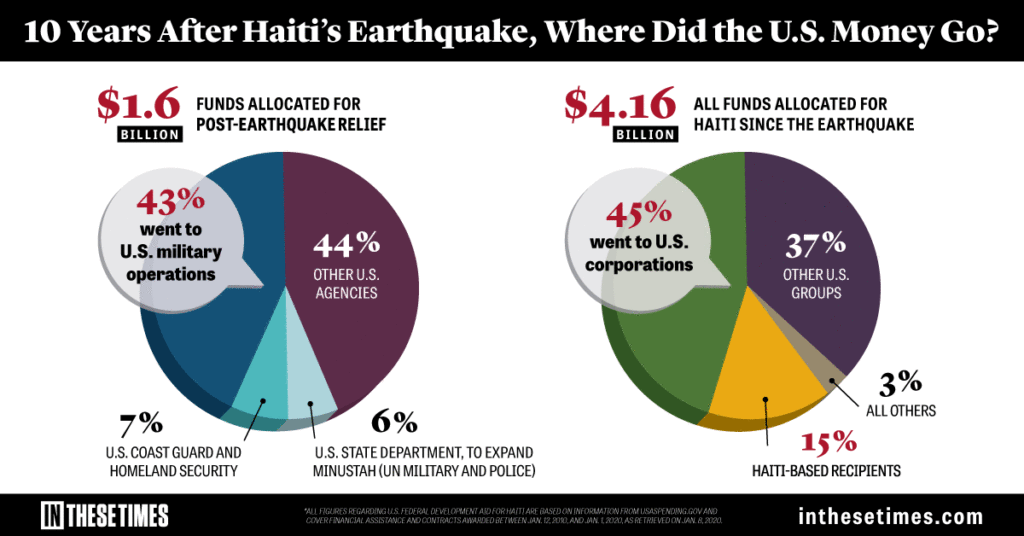10 Years Ago, We Pledged to Help Haiti Rebuild. Then What Happened?
LATIN AMERICA AND THE CARIBBEAN, 20 Jan 2020
Isabel Macdonald – In These Times
12 Jan 2020 – Hundreds of millions in aid went to U.S. corporations and the U.S. military. A fraction went to Haitian institutions.
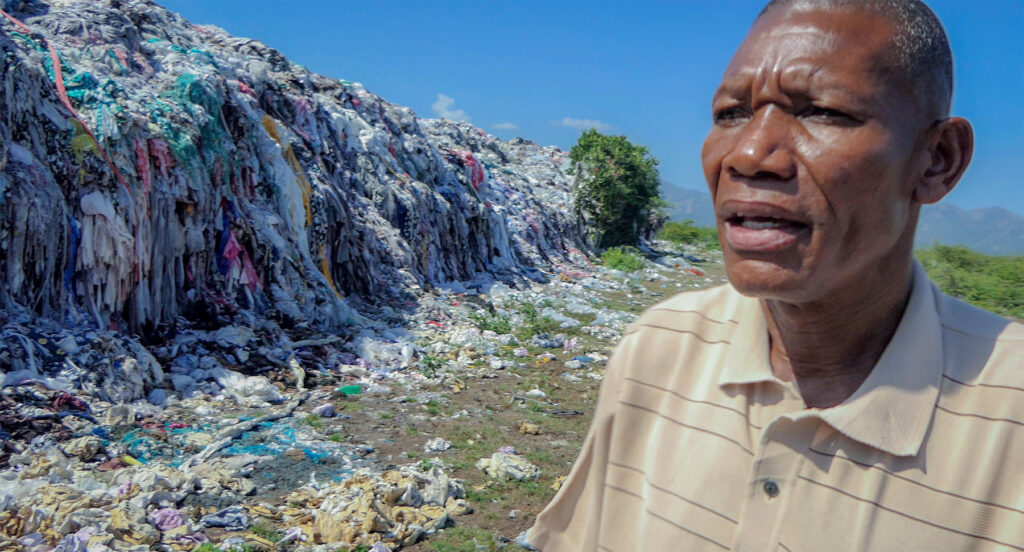
“There was no garbage here before,” environmental activist Milostène Castin says, gesturing at a mountain of trash produced by the garment manufacturing center in Caracol, Haiti. The industrial park was built with the help of $202 million in U.S. recovery funds earmarked from the 2010 earthquake, though the area was untouched by the disaster.
The earthquake that struck Haiti on Jan. 12, 2010, unleashed one of the worst humanitarian crises in decades. In hard-hit places like Port-au-Prince, Haiti’s capital and most densely populated city, schools and medical centers collapsed. More than 300,000 homes were damaged or destroyed. The disaster is estimated to have killed at least 220,000 Haitians and displaced 2.3 million—about a quarter of the population.
The crisis also unleashed an unprecedented humanitarian response. Charity groups, private individuals and governments around the world offered support. At a United Nations conference in New York on March 31, 2010, 58 donors pledged more than $8.3 billion to help Haiti “build back better,” reducing the nation’s vulnerability to future disasters. The United States made the biggest pledge of any nation, promising $1.15 billion. Then-U.S. Secretary of State Hillary Rodham Clinton emphasized Haiti’s urgent needs: safe homes, food security and basic services that were not broadly accessible even before the earthquake—including healthcare, potable water and a national system of sanitation.
A decade later, for many, conditions are still worse than before.
The U.S. Congress ultimately approved more than $1.6 billion for emergency humanitarian relief and more than $1.14 billion for recovery. The United States went on to finance other Haitian development projects, bringing the total in post-earthquake commitments to almost $4.16 billion.
But relatively little of the housing that was destroyed in hard-hit areas like Port-au-Prince has been rebuilt. More than 34,000 Haitians who lost their homes still live in displacement camps, and more than 300,000 Haitians have migrated to new slums just north of the capital that lack healthcare services and potable water. Many Haitian families have even less access to food. And there is still no functioning national sanitation system; more than 10,000 have died of cholera since the earthquake.
So where did all that aid money go?
To find out, In These Times reviewed U.S. government spending records and spent three weeks on the ground in Haiti in July 2019. Of the $1.6 billion committed to humanitarian relief, we found all of it bypassed Haitian institutions—and more than a third went directly to the U.S. military.
Of the $1.14 billion for recovery, more than a fifth was earmarked for the partial cancelation of debt to multilateral organizations such as the Inter-American Development Bank (IDB) and the World Bank. Another $10 million went to overhead for the U.S. Agency for International Development (USAID), the agency that channeled much of the recovery money.
Nearly a quarter of what remained—$202 million—was allocated to infrastructure projects, but not to rebuild Port-au-Prince or other hard-hit areas; they were to provide electricity, transportation and housing for a new industrial park in Caracol, a community in northern Haiti untouched by the earthquake. To date, the United States has committed $160 million of these funds and given an additional $15 million to the State Department to help build the park itself.
In These Times visited Caracol, where Haitian workers are paid $5.25 a day to sew clothing for American brands like Gap, Walmart and Target. We found it has introduced a host of new problems, including increased food insecurity, exposure to pollution, unlivable wages and workplace sexual harassment.
Rather than addressing Haiti’s needs, much of the recovery aid has instead made Haiti even more vulnerable to environmental disasters, including severe droughts intensified by climate change. As climate change exacerbates disasters around the world, this raises questions about the potential consequences of U.S. disaster aid for many other countries.
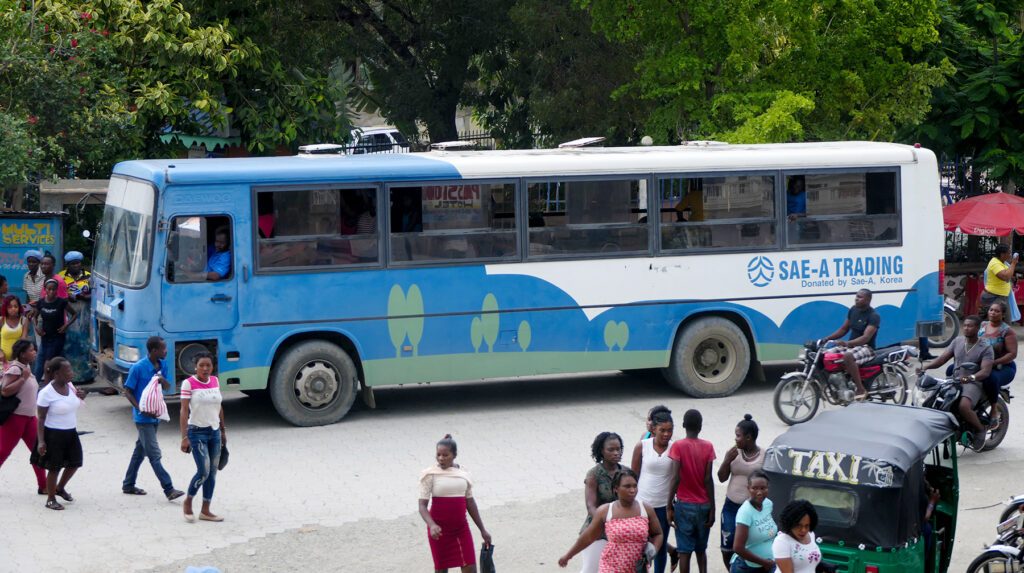
Garment workers return from the Caracol Industrial Park, where they make $5.25 a day, a third of the cost of living in Haiti.
As the Haitian government acknowledged at the 2010 UN donors’ conference, the deadly toll of the earthquake was not caused by tremors alone. The dangerous conditions that followed are, in many ways, inseparable from the ongoing dynamics of Haiti’s colonial past.
Modern Haiti was founded in 1804 after the world’s only successful slave revolution, winning its independence from France after a century of brutal slavery. But France refused to recognize Haiti’s sovereignty until the nation paid its former colonizer an indemnity of 150 million gold francs, compensation for French “property” lost—including the enslaved people who won their freedom. Haiti paid the debt with high-interest loans—sometimes devoting 80% of its national budget to repayment—until 1947, which hamstrung the development of basic infrastructure and services.
The United States, for its part, failed to recognize Haiti’s sovereignty until after the Confederacy seceded. Since the U.S. first occupied Haiti—from 1915 to 1934, as part of a broader strategy to secure exclusive influence in the area surrounding the nearby Panama Canal—the United States has worked to reorient the country’s economic and political system to better serve U.S. and transnational corporations.
To this end, the United States supported the Duvalier dictatorships from 1957 to 1986. Then, in 1991, when the Haitian military ousted Haiti’s first democratically elected president, Jean-Bertrand Aristide, the United States covertly supported death squads targeting his supporters. The United States eventually agreed to Aristide’s return, on condition he implement neoliberal reform recommendations from the World Bank—a reversal of the platform Aristide campaigned on. Such policies, pushed on Haiti since the 1980s by aid donors and multilateral financial institutions, have undermined Haitian public services by slashing social spending and privatizing state enterprises. These reforms have also undermined the livelihoods of Haitian farmers by removing tariffs on food imports that previously protected them from unfair competition from U.S. agribusiness. These reforms, commonly referred to in Haiti as Plan Lanmò—“the death plan” in Creole—had catastrophic effects on Haitian agriculture, and precipitated a mass migration of Haiti’s rural population to cities like Port-au-Prince, thus contributing to the urban population density that has been cited as a factor in the earthquake’s deadly toll.
When Aristide was reelected in 2000, the United States successfully pressured the IDB to block a series of loans it had promised for Haiti, earmarked for healthcare and basic services, including potable water and education.
In 2004, the United States supported a second coup to remove Aristide and sent troops for another occupation, later supported by a UN stabilization effort known as the Mission des Nations Unies pour la stabilisation en Haïti, or Minustah.
Living in dangerously constructed homes in the overcrowded capital, without reliable healthcare or potable water, Haitians were, thanks in large part to years of neoliberal policy and ongoing U.S. interference, particularly vulnerable during both the earthquake and the cholera epidemic that followed.
At the 2010 UN donors’ conference, Clinton emphasized the need for donors to avoid bypassing Haitian public institutions. “It will be tempting to fall back on old habits—to work around the government rather than to work with them as partners,” she cautioned.
Despite Clinton’s warning, much aid exemplifies the same pattern. Of the $1.6 billion relief budget, none was allocated directly to any public Haitian institutions, according to the Congressional Research Office. By far the largest portion of this aid, $655 million (about 40%), was earmarked directly for the U.S. military, which received an additional $40.5 million from USAID.
The overwhelming majority of international donors followed suit. According to the UN Office of Paul Farmer, UN deputy special envoy for Haiti from 2009 to 2012, less than 1% of relief aid disbursed by donor nations and multilateral organizations by 2012 went to Haiti’s public institutions.
Farmer cautioned in 2011, “With … relief funding circumventing Haitian public institutions, the already challenging task of moving from relief to recovery—which requires government leadership, above all—becomes almost impossible.”
The earthquake destroyed many public buildings, undermining Haiti’s already weak public sector. Some Haitian institutions, however, did survive, and were arguably better positioned than the U.S. military to provide relief. For example, Haiti’s most important medical facility, General Hospital, remained standing. Haitian NGOs could likely have distributed food and water more quickly and to greater numbers than the U.S. military, whose operations were limited by language barriers and its self-imposed restriction to operate only in zones it deemed “secured.”
The U.S. Department of Defense (DOD) deployed 22,000 personnel, more than 300 aircraft and 33 ships to Haiti, instructed to “save lives” and “mitigate human suffering”—but the goals of military security and control seemed to take precedence. One of the military’s first actions was to seize control of air traffic at the main Port-au-Prince airport, a move the military claimed was necessary to ensure order—but also, as Haïti Liberté reported, blocked life-saving humanitarian relief supplies and emergency search and rescue personnel. As the New York Times reported, U.S. commanders turned away World Food Program flights “so that the United States could land troops and equipment, and lift Americans and other foreigners to safety.” One search and rescue team from the U.K. was blocked from landing, as were five planeloads of supplies for Doctors Without Borders, whose staff resorted to buying a saw from the local market for amputations.
More than a week after the earthquake, General Hospital still hadn’t received supplies and medicines needed to treat hundreds of dying patients. One doctor identified the disproportionate emphasis on security as “our major block to getting aid in.” While the U.S. military and the international response saved Americans and Western expats, journalists and researchers reported much of the work of digging out Haitian survivors from collapsed buildings was done, in fact, by other Haitians, often with bare hands.
About 6% of the U.S. relief money, $96.5 million, went to the U.S. State Department, which funded more soldiers and police for Minustah. Minustah’s infamous contribution to the relief effort is a deadly cholera epidemic, cholera being unknown in Haiti before October 2010. Despite the well-documented fact that Haiti lacked a basic sanitation system, cholera-infected Minustah soldiers from Nepal were housed at a military base whose sewage UN contractors dumped near important water sources, triggering the outbreak. After denying its role for years, the UN apologized in 2016.
The U.S. Coast Guard, which received $50 million for its role in the disaster response, deployed 16 cutters to patrol Haitian and international waters—to ensure, as Lt. Cmdr. Chris O’Neil, a Coast Guard spokesperson, told the Washington Times, that no one “try to enter the United States illegally by sea.” Meanwhile, the DOD flew one of its cargo planes over Haiti five days after the quake, broadcasting a loud, pre-recorded announcement in Creole: “If you think you will reach the U.S. and all the doors will be wide open to you, that’s not at all the case. They will intercept you right on the water and send you back home where you came from.”
The United States also awarded the private prison corporation GEO Group more than $540,000 to prepare for a “Haiti surge” through operations in Cuba, where the U.S. had recently prepared a migrant detention camp on its naval base in Guantanamo Bay. But Haitians did not flee their country in droves and, in fact, the number of Haitian migrants intercepted by the Coast Guard decreased the year after the disaster. More than 1.5 million homeless earthquake survivors, however, formed camps throughout Port-au-Prince during that same time. Many reported they received no humanitarian assistance whatsoever.
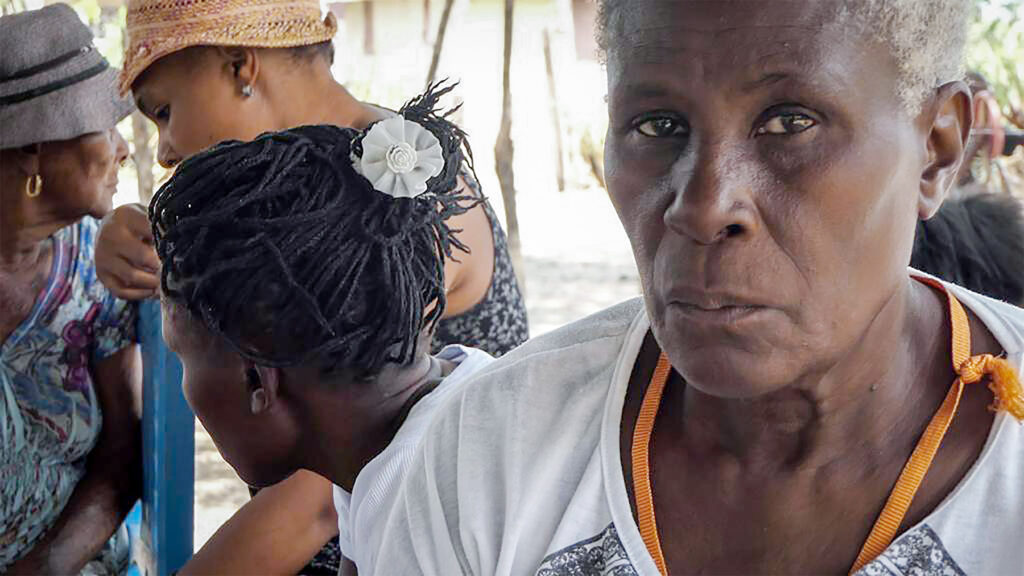
The land farmed by Ilna Saint Jean, 60, in Caracol, Haiti, which supported her nine children, was spared by the 2010 earthquake but seized for an industrial park during the “recovery.”
Ilna Saint Jean remembers all the crops her family used to grow where the Caracol Industrial Park now sits. On her half-hectare plot, the 60-year-old peasant farmer recalls, “We had yucca, corn, black beans, pigeon peas, okra, peanuts, all kinds of stuff.” This plot, in the farmland area referred to by locals as Tè Chabè, allowed Saint Jean to support her nine children. The community was untouched by the 2010 earthquake.
One year later, however, in January 2011, “everything was lost,” Saint Jean says. A Haitian government agent arrived without warning and removed her fence. The yucca, beans and other plants were soon entirely destroyed by roaming animals.
“They told us the land doesn’t belong to us, it’s the state’s land, it’s the foreigners’ land,” Saint Jean says. “They came and took the land, they cemented it, and they made that industrial park on it.”
Saint Jean is one of 442 peasant farmers who lost their crops and their farmland in the evictions for the industrial park.
While supporters describe the industrial park as a flagship project of post-earthquake recovery, the plans for it had actually been discussed months before the disaster, at a trade conference convened by the IDB and the William J. Clinton Foundation, a nonprofit founded and directed by former President Bill Clinton. Such industrial parks are central to the neoliberal economic model the U.S. government has pushed for decades. This model has long held that low-wage sectors like garment manufacturing are a necessary stepping stone to prosperity for countries like Haiti, and that governments should offer tax breaks and incentives for private corporations to set up shop. Unfortunately, because these factories pay workers so little, they can also exacerbate pre-existing economic and social inequalities. Moreover, garment manufacturing is often detrimental to local communities and environments, given its high water requirements and polluting waste.
The U.S. government has championed garment manufacturing as a viable economic development strategy for Haiti since the 1970s, proclaiming Haiti could become “the Taiwan of the Caribbean.” With U.S. support, employment in the garment industry—which, at the time, had largely been concentrated in Port-au-Prince—peaked in the 1980s. Partly because of the extremely low wages, however, these factories never kickstarted the promised economic boom. They also spurred the rise of slums, attracting tens of thousands of job-seekers to Port-au-Prince who could not afford standard housing.
Despite these problems, the U.S. continued to create incentives for the Haitian garment industry. HOPE II, a 2008 trade deal between the United States and Haiti, allows Haitian-made textiles to enter the U.S. without tariffs, an attractive lure for companies from around the world.
The Haitian government’s Action Plan for National Recovery and Development, unveiled at the March 2010 UN donors’ conference, articulated a vision of reconstruction based on a more just society, capable of meeting Haitians’ basic needs, with an emphasis on housing and environmentally sustainable projects. But it also included more industrial parks for such sectors as textile production.
The Interim Haiti Recovery Commission, an international body mandated to ensure accountability in the post-earthquake rebuilding and co-chaired by Bill Clinton, approved the construction of the Caracol park. Hillary Clinton’s State Department recruited Sae-A, a major Korean garment manufacturer, as its anchor tenant.
The Haitian government agreed to provide the land, the IDB offered $100 million for construction, and the United States pledged $124 million for a power plant, a new port (later cancelled), and a housing project. Sae-A committed $78 million to the project and predicted 20,000 new jobs, scoring free facilities and tax breaks in exchange.
Before the deal was signed, the AFL-CIO warned the U.S. government about Sae-A’s record of “acts of violence and intimidation” in Guatemala, where it closed its flagship factory in 2011, after threatening to leave the country following a dispute with a local union.
Environmentalists also raised concerns about water and waste, given the site was on some of Haiti’s most fertile farmland and close to Caracol Bay, a fragile marine ecosystem home to critically endangered species and an important source of food and income for many in Caracol. The mayor of Caracol was not informed of the project until after the site had been decided. The U.S. consulting firm that proposed the site, Koios Associates, later admitted it had not carried out an environmental assessment; upon review, the consultants rated the project “high risk” and recommended either a change of location or to just end the project altogether.
The project’s backers charged forward.
The industrial park opened its doors in 2012. Seven years later, In These Times visited Caracol to find the labor and environmental concerns were well founded. Through interviews with factory workers and evicted peasant farmers, union reps and a local environmental group, it emerged that this U.S.-backed project created a host of new problems for thousands of Haitians.
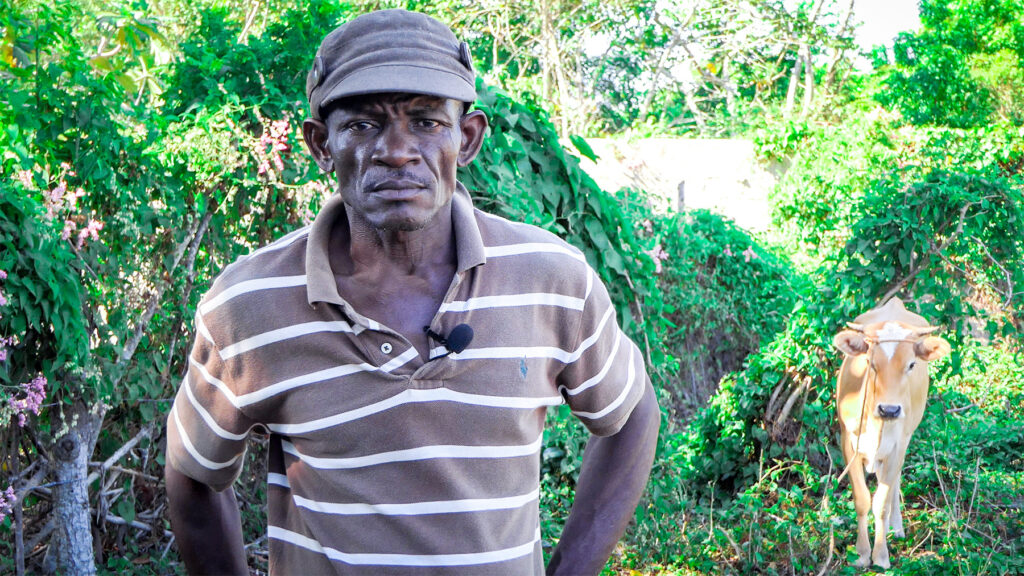
Wilson Menard, 53, represents a collective of farmers whose land was taken for the site of the Caracol Industrial Park after Haiti’s 2010 earthquake. He says his livestock was more resilient on the land that was seized; only one of his three cows survived a recent drought.
Land rights have been a focal point of Haiti’s long struggle to maintain its independence since 1804. In the first U.S. military occupation (1915–34), authorities rewrote Haiti’s constitution to remove a popular provision that limited land ownership to Haitian nationals. Thousands of peasant farmers were subsequently displaced in areas such as Tè Chabè, where the Caracol Industrial Park now sits, so that large swaths of land could be deforested for U.S. agribusiness plantation crops like sugar and sisal. Haitian farmers finally reclaimed the land after the 1986 uprising that led to the fall of the brutal U.S.-backed Duvalier dictatorships.
Many of the farmers evicted for the Caracol Industrial Park had been farming there since the late 1980s. The site’s 608 acres had provided a living for 442 families, supporting an estimated 4,000 people in the area.
While a few farmers owned their plots, most simply had customary rights to the land—which should have been respected under Haitian and international law, according to ActionAid, an international nonprofit that has been working to support the displaced farmers. For most of these farmers, the land seized for the park was one of the only forms of financial security available, according to Wilson Menard, a 53-year-old peasant farmer and representative of a community organization the farmers founded, Kolektif Peyizan Viktim Tè Chabè. One’s access to a piece of land could always be traded for money, Menard explains, acting like an insurance policy or emergency savings. For this reason, Menard, who was himself evicted from the land, says, “Losing a piece of land, it has a huge consequence.”
The seized land was some of Haiti’s most fertile. Dense green foliage of mango and plantain trees peeks over the top of the concrete perimeter wall surrounding the park. Many farmers used this land not only to grow a rich array of crops, but to keep livestock—another crucial source of financial security, Menard explains, as a cow can always be sold.
Since the park opened, the price of the remaining land in the area has skyrocketed, making it impossible for most of the displaced farmers to rent or buy a piece. Moreover, the remaining land is much less fertile than what was paved over. While Menard has been able to sublet a small plot outside the park, two of his three cows died in the drought of 2018–19; he is adamant the animals would have survived on the Tè Chabè land, where there was enough foliage to sustain grazing animals even during drought. Before the evictions, he says, “Animals didn’t die like that.”
Residents told In These Times that the remaining land has also suffered environmental degradation from the manufacturing itself—air pollution, aquatic pollution and waste dumps. As Milostène Castin, of the local environmental group AREDE, gazes at an enormous pile of trash from the park, just a few miles away in the community of Madras, he says, “It’s a wrong they’re doing to the community, which will have a big impact on generations [to] come.”
Local fishermen report that catching fish is more difficult since the industrial park opened, and that some species seem to have disappeared altogether. Saint Jean, whose family lives less than five miles from the industrial park, as well as from the mountains of factory garbage, reports that air quality has deteriorated. As some of the garbage from the factories is burned, a “huge smoke rises in the air and then comes down,” she says. Several others also confirmed this.
The Haitian government promised to “look for land” for the farmers it evicted, llna recalls. Instead, more than 10 months after the eviction, the farmers were issued cash payments as compensation for lost crops.
This money has long since run out, according to the Kolektif, and families are growing increasingly desperate. “It’s become worse,” Saint Jean says. “We wake up hungry, we go to bed hungry.”
In 2017, the Kolektif filed a complaint with the accountability office of the IDB. After more than a year of negotiations, they arrived at a settlement, which was originally supposed to take effect in March 2019. Most of the compensation promised to the displaced farmers, however, had not been delivered as of December 2019, according to ActionAid.
Under the terms of this agreement, one member of each family is “eligible” for employment in the industrial park. The rest must choose between other forms of compensation, which could include specialized technical support, microcredit programs, vocational training or land. Of the 442 farmers who lost their land, no more than 100 may receive new land.
According to ActionAid, just 12% of these families have managed to secure employment in the industrial park. And the value of that employment is unclear.
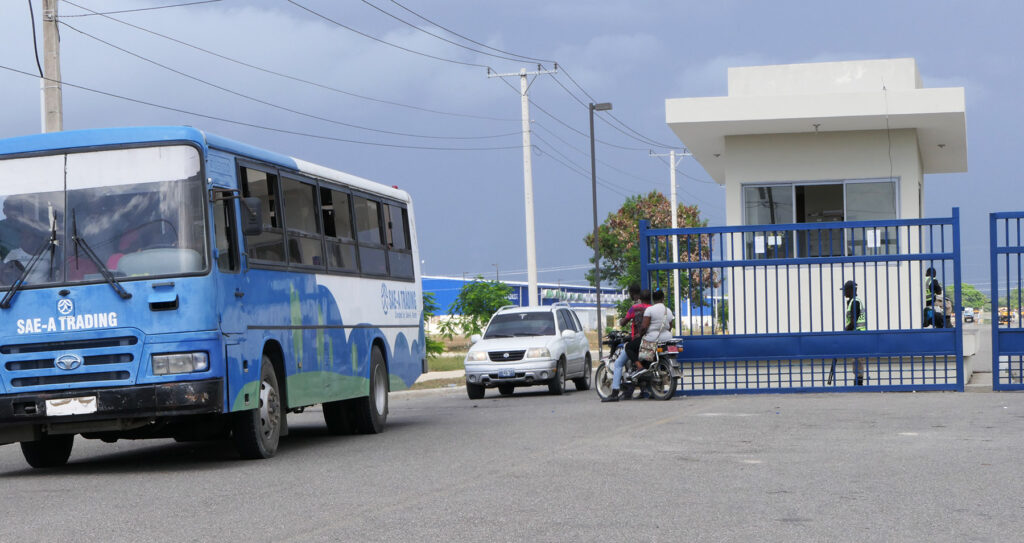
The $202 million allocated by the United States for projects to support the Caracol Industrial Park represented nearly a quarter of the U.S. Congressional funds for Haiti’s recovery that were not earmarked for debt relief or USAID operating expenses.
The backers of the Caracol Industrial Park have claimed it will create up to 60,000 local jobs. At the ceremony that established the Caracol Industrial Park in September 2010, Hillary Clinton assured the public that the jobs at Sae-A’s new factories would be “not just any jobs; these are good jobs with fair pay that adhere to international labor standards.”
So far, just 13,000 of the 60,000 projected jobs have been created, and most pay unlivable wages. Haitians who do the physically demanding and repetitive work of sewing and assembling clothing in the new industrial park earn the Haitian minimum wage of just 500 gourdes (about $5.25 U.S.) a day—three times less than the estimated cost of living in Haiti, according to the Solidarity Center.
The park’s largest employer is S&H Global, Sae-A’s wholly owned Haitian subsidiary, whose biggest customer is Walmart. Other Caracol factories include Taiwanese firm Everest Apparel and Sri-Lankan-owned Mas Akansyel, both of which manufacture clothing for Nike and Puma. According to the International Labor Organization’s Better Work Program, these three companies have all repeatedly been found to violate Haitian and international labor laws, with numerous breaches of health and safety regulations, wage theft, temperatures that exceed safe levels, verbally abusive bosses and sexual harassment.
When Philogène Nelange, now 35, heard about the opening of the new industrial park in Caracol, he had high hopes. He had grown up in the nearby commune of St. Suzanne, where there were few viable prospects for young people. “I thought that, with the arrival of the factory, things would be better,” Nelange says.
He landed a job at S&H Global. Three years later, the salary he makes is barely enough to cover a single worker’s expenses. Sitting on the porch of the tiny two-room home he rents in Trou-du-Nord with his wife and three kids, he says he often can’t sleep at night because he’s so worried. “It’s not even enough for food,” he says bluntly. Yet he also has to cover the costs of rent and utility bills, drinking water and school tuition (water and education being largely unsubsidized by the government). While S&H Global built a school in Caracol that provides free schooling to 500 local children, Nelange says this is insufficient to serve its more than 10,000 employees, many of whom have young children.
One young seamstress at S&H Global spoke with In These Times on the condition of anonymity, fearing retribution. She says she was suspended without pay for refusing her boss’s unwanted sexual advances. “He asked me to sleep with him,” she explains. “I didn’t agree.”
Another young woman, who applied for a job at S&H Global in the summer of 2019, tells In These Times that a manager offered to push her application forward in exchange for sex.
Unité Technique d’Exécution, the Haitian government office responsible for managing the industrial park, says it has a zero tolerance policy on sexual harassment and requires companies to have procedures in place for workers to report such violations.
Karen Seo, senior public relations manager at Sae-A, tells In These Times via email that Sae-A takes a proactive stance to detect and address workplace problems, including sexual harassment, through trainings and disciplinary actions.
A Haitian government spokesperson added that a 2018 report of sexual harassment at the park resulted in disciplinary action against a perpetrator.
Yet sexual harassment remains endemic across the factories, according to a representative from one of the unions working at the industrial park, who feared retaliation if their name was used. “Each week, you hear a different complaint,” they say, adding that discipline and even firings are common if a worker refuses a superior. They estimated more than 60 workers have been fired in the past four years at their factory for this very reason.
Factory workers have also filed complaints with Haitian authorities, saying that company grievance procedures had failed to address their reports of physical violence at the factory and of bribes being demanded in exchange for employment, according to the government spokesperson.
Even IDB’s Haiti department manager, José Agustín Aguerre, admitted in an interview with the New York Times before the park opened its doors, “Creating an exclusively garment maquiladora zone is something everyone—I wouldn’t say tries to avoid, but considers last resort.” He also defended the decision, calling this “last resort” strategy “a good opportunity” because of Haiti’s very high unemployment.
But with such low wages, the garment factories have little capacity to stimulate the economy. As Haitian economist Camille Chalmers put it in an interview with Haiti Grassroots Watch: “It’s a big error to bet on slave-wage labor, on breaking the backs of workers who are paid nothing while [foreign] companies get rich. It’s not only an error, it’s a crime.”
Of the total of $4.16 billion the U.S. government awarded for projects in post-earthquake Haiti, for-profit U.S. corporations received a greater share than any other single group: $1.86 billion, about 45%.
Anti-corruption protests have swept Haiti for the past two years, precipitated by evidence that the U.S.-backed governments of Haitian President Jovenel Moïse and his predecessor misappropriated hundreds of millions of dollars from a Venezuelan aid program for subsidized oil.
But for Castin, of the environmental group AREDE, who has played an active role in these protests, the fundamental issues at stake—in the anti-government demonstrations and the ongoing struggle around the Caracol Industrial Park—are, in many ways, the same. In both cases, Haitians are fighting for greater accountability in how aid money is spent, and for a future that serves the needs of Haitian communities.
At the 2010 UN donors’ conference, which was called “Towards a New Future for Haiti,” similar aspirations were voiced. Hillary Clinton acknowledged that years of prior aid to Haiti had failed to address basic needs, and emphasized the need for donors to “hold ourselves accountable.” Clinton warned, “We cannot retreat to failed strategies.” Yet U.S. aid in post-earthquake Haiti has been premised on longstanding imperialist assumptions, including the belief that Haiti’s most viable path of development is through foreign corporations taking advantage of devalued Haitian labor—even as Haitian export manufacturing workers continue to be paid less than any other workers in the hemisphere—and the related belief that military control of Haiti’s population is required to ensure stability for foreign investment.
Of the nearly $918 million Congress approved for recovery projects, more than $302 million (almost a third of the budget) was earmarked for “governance and rule of law.” In addition to funding the expansion of Minustah and prison construction, this U.S. recovery aid was used to strengthen the Haitian National Police (HNP), including support for its SWAT and civil order units. Since 1995, the United States has provided extensive support for this domestic police force in Haiti, which the Haitian government uses to “keep the peace”—most recently, to put down the anti-corruption protests. More than 40 Haitian protesters have been killed in clashes with the HNP since August 2019.
The failures of the neoliberal policies that have long guided U.S. aid have never been more apparent than they are today in Haiti, a country that once produced enough food to feed its population in the 1980s and is now almost entirely dependent on U.S. food imports.
Nelange places much of the blame on Haiti’s low minimum wages. Caracol factory workers like Nelange face U.S. prices for many food staples while earning a minimum day wage—which was 420 gourdes, just under $5, until November 2019.
Garment manufacturing companies in Haiti and their allies in the U.S. government have long fought wage increases. When Haiti’s lower parliament voted in March 2019 to raise the daily wage to about $8.25 for export manufacturing workers, S&H Global canceled an expansion at Caracol that would have created 10,000 jobs, choosing instead to send those jobs to the Dominican Republic.
In the end, garment workers won only a modest increase, effective November 2019, to 500 gourdes (about $5.25 today). A spokesperson for Sae-A confirmed to In These Times that the company is nonetheless “building a factory in D.R. as a backup now.”
Meanwhile, soaring inflation, combined with rapid devaluation of the gourde, has made basic necessities even more unaffordable. Reached by telephone in December 2019, Nelange said his family can now barely even afford potable water.
“You can’t live,” he says.
Castin has some advice for future aid donors “so as not to repeat the same mistakes as the Caracol Industrial Park.” He emphasizes the need for a more participatory and transparent approach; advance assessments of the economic, social and environmental risks of aid projects; and mechanisms of accountability, including grievance offices in affected communities.
At minimum, Castin says, the United States should not “use American people’s tax money to finance projects that forcibly displace Haitian peasants from fertile land that is their principal source of revenue.”
______________________________________________
The print version of this article incorrectly stated that the $202 million allocated by the United States for projects to support the Caracol Industrial Park represented a third of the U.S. Congressional funds for Haiti’s recovery that were not earmarked for debt relief or USAID operating expenses. The correct figure, indicated in the online version of the article, is nearly a quarter. The print article also incorrectly stated that Milostène Castin had been arrested and jailed in anti-corruption protests. In These Times regrets these errors.
This story was supported by a grant from the Leonard C. Goodman Institute for Investigative Reporting. Sophonie M. Joseph provided translation assistance. Ria Bhagwat, Isabel Carter and Juan Caicedo provided fact-checking.
Photos by Jeremy Dupin
Isabel MacDonald is an investigative journalist based in Montreal who has traveled to Haiti frequently since 2005.
Jeremy Dupin is an Emmy-winning journalist and filmmaker.
Go to Original – inthesetimes.com
Tags: Conflict, Corruption, Democracy, Geopolitics, Haiti, Hegemony, Human Rights, Imperialism, International Relations, Latin America Caribbean, Military Intervention, Neocolonialism, US Military, USA
DISCLAIMER: The statements, views and opinions expressed in pieces republished here are solely those of the authors and do not necessarily represent those of TMS. In accordance with title 17 U.S.C. section 107, this material is distributed without profit to those who have expressed a prior interest in receiving the included information for research and educational purposes. TMS has no affiliation whatsoever with the originator of this article nor is TMS endorsed or sponsored by the originator. “GO TO ORIGINAL” links are provided as a convenience to our readers and allow for verification of authenticity. However, as originating pages are often updated by their originating host sites, the versions posted may not match the versions our readers view when clicking the “GO TO ORIGINAL” links. This site contains copyrighted material the use of which has not always been specifically authorized by the copyright owner. We are making such material available in our efforts to advance understanding of environmental, political, human rights, economic, democracy, scientific, and social justice issues, etc. We believe this constitutes a ‘fair use’ of any such copyrighted material as provided for in section 107 of the US Copyright Law. In accordance with Title 17 U.S.C. Section 107, the material on this site is distributed without profit to those who have expressed a prior interest in receiving the included information for research and educational purposes. For more information go to: http://www.law.cornell.edu/uscode/17/107.shtml. If you wish to use copyrighted material from this site for purposes of your own that go beyond ‘fair use’, you must obtain permission from the copyright owner.
Read more
Click here to go to the current weekly digest or pick another article:
LATIN AMERICA AND THE CARIBBEAN:
